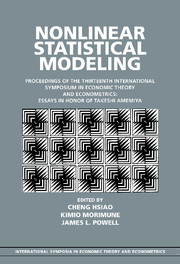 Nonlinear Statistical Modeling
Nonlinear Statistical Modeling Published online by Cambridge University Press: 05 June 2012
Introduction
If we have several successive durations for each of a number of individuals, we can consider the ossibility that the distribution of any one de ends on the values taken by earlier durations in the sequence. Such a de endence has been called lagged duration de endence. If the durations are those of s ells of unem loyment, a briefer and more evocative hrase is scarring. This effect might work through a learning rocess (for exam le, the agent's beliefs might be de endent on the lengths of his revious s ells); it might work through a signaling rocess in which em loyers use the lengths of revious s ells in formulating their current job offers. Whatever the mechanism, it seems useful to be able to make a consistent estimate of the scarring effect, and this cha ter aims to rovide that.
In many otential a lications (for examle, unemloyment) it is likely that the number of durations available for any individual is small. On the other hand, we may well have many individuals for whom the scarring effect, if it exists, might reasonably be assumed the same. This thought leads us to consider how to do inference about scarring with a sam le of many individuals, each of whom contributes a small number of durations. So the roblem is that of inference about autoregressive models for short, but broad, anel duration data.
To save this book to your Kindle, first ensure [email protected] is added to your Approved Personal Document E-mail List under your Personal Document Settings on the Manage Your Content and Devices page of your Amazon account. Then enter the ‘name’ part of your Kindle email address below. Find out more about saving to your Kindle.
Note you can select to save to either the @free.kindle.com or @kindle.com variations. ‘@free.kindle.com’ emails are free but can only be saved to your device when it is connected to wi-fi. ‘@kindle.com’ emails can be delivered even when you are not connected to wi-fi, but note that service fees apply.
Find out more about the Kindle Personal Document Service.
To save content items to your account, please confirm that you agree to abide by our usage policies. If this is the first time you use this feature, you will be asked to authorise Cambridge Core to connect with your account. Find out more about saving content to Dropbox.
To save content items to your account, please confirm that you agree to abide by our usage policies. If this is the first time you use this feature, you will be asked to authorise Cambridge Core to connect with your account. Find out more about saving content to Google Drive.